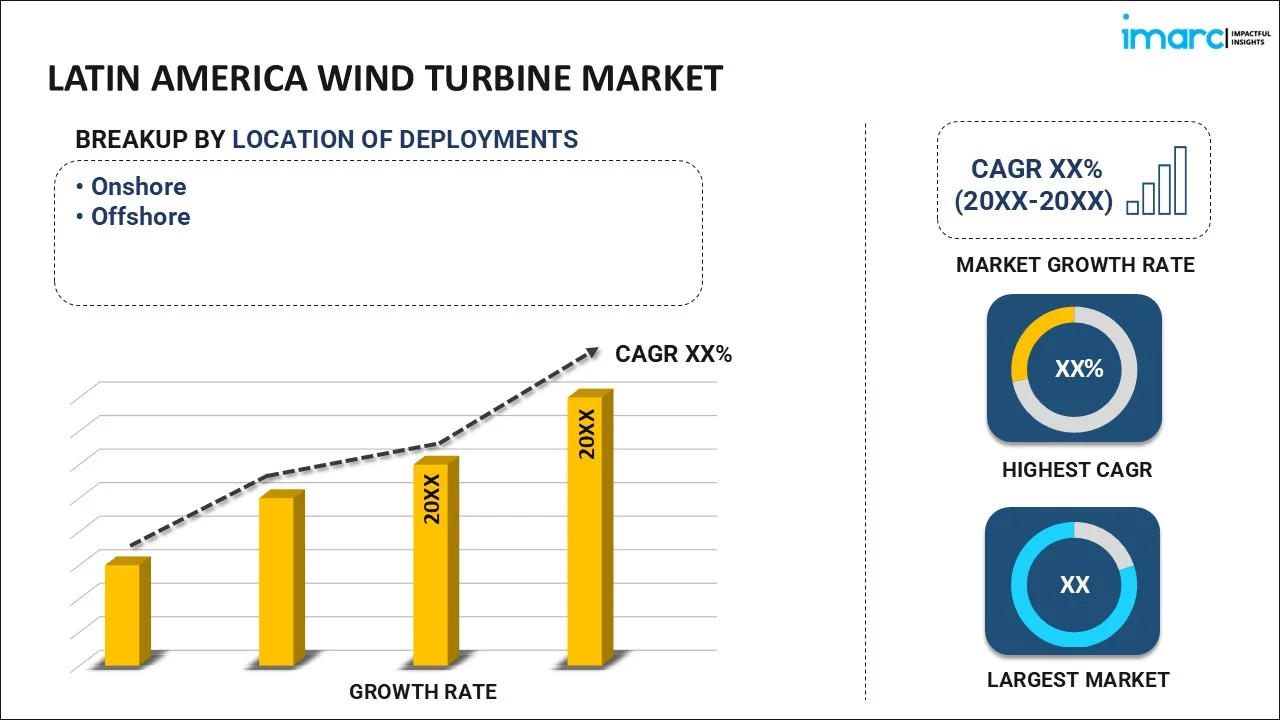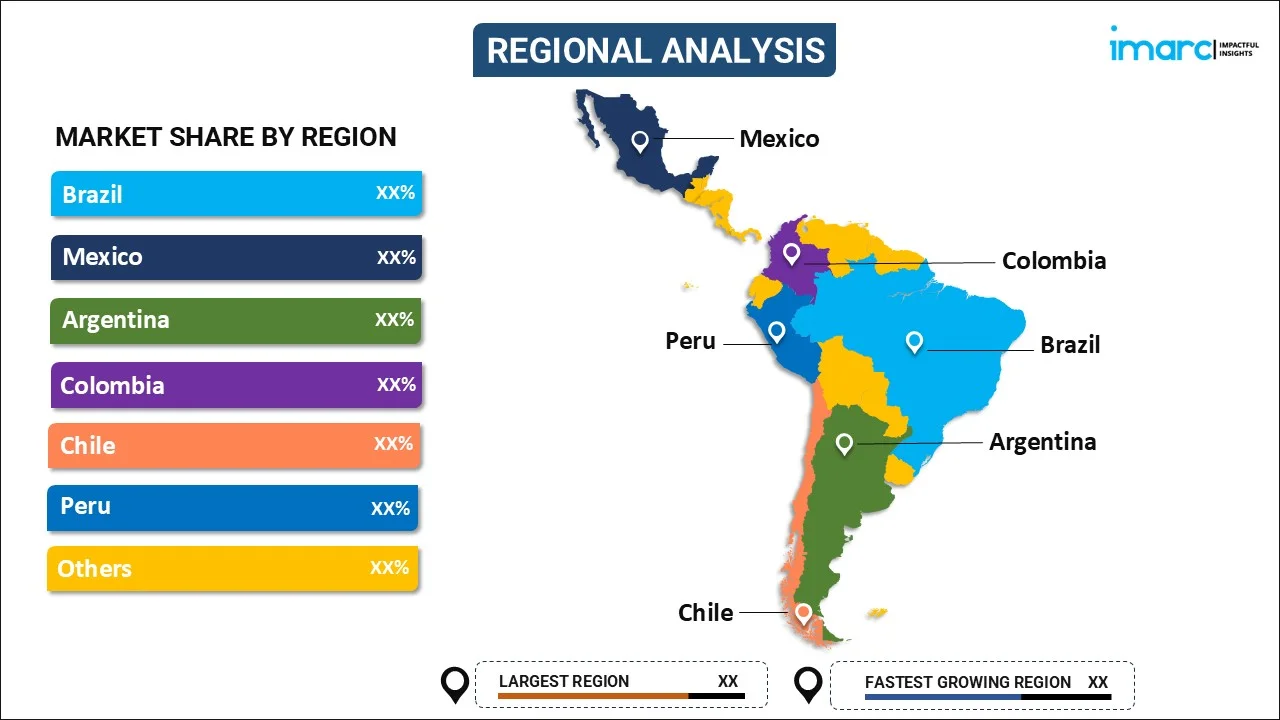
Latin America Wind Turbine Market Size, Share, Trends, and Forecast by Location of Deployment and Region, 2025-2033
Latin America Wind Turbine Market Overview:
The Latin America wind turbine market size reached 6.61 Gigawatt in 2024. Looking forward, IMARC Group expects the market to reach 190.66 Gigawatt by 2033, exhibiting a growth rate (CAGR) of 45.30% during 2025-2033. The market is witnessing significant growth due to the increased investment in renewable energy infrastructure and technological advancements and cost reduction are expanding the market. The market is further driven by the significant technological advancements.
|
Report Attribute
|
Key Statistics
|
|---|---|
|
Base Year
|
2024 |
|
Forecast Years
|
2025-2033
|
|
Historical Years
|
2019-2024
|
| Market Size in 2024 | 6.61 Gigawatt |
| Market Forecast in 2033 | 190.66 Gigawatt |
| Market Growth Rate (2025-2033) | 45.30% |
Latin America Wind Turbine Market Trends:
Increased Investment in Renewable Energy Infrastructure
A rapid growth in Latin American wind turbine market is apparently the result of increased investments into renewable energy infrastructure. Government after government in Latin America is conscious of the need to shift energy generation and use into more sustainable options and has, therefore, provided favorable policy implementation and financial incentives on wind energy projects. As Brazil, Mexico, Chile, and Argentina strive to meet renewable energy targets to offer lower dependency on fossil fuels and mitigate adverse impacts of climate change, wind power capacity sees substantial zonal growth in these countries. For instance, in January 2025, Colbún announced an investment of $700 million in Chile’s largest wind farm, Horizonte, with 140 turbines and 816 MW capacity. Horizonte reflects Colbún's commitment to carbon neutrality and sustainable energy, with a $200 million expansion to reach 996 MW by 2025. Brazil, in particular, is a leader in the Latin American wind market, with the country’s wind power generation increasing significantly in recent years. This trend can well be exemplified by the expansion of wind farms in northeastern Brazil, where wind resources are exceptionally strong. Conversely, Mexico seeks diversification of its energy mix by developing both onshore and offshore wind farms to utilize the vast wind resources along its coasts. The commitment of Latin American nations to carbon emission reduction and the increasing share of renewable energy in the energy mix are expected to foster investments in wind energy projects. Besides, the increasing interest of international players, with strong growth prospects, is expected to further develop the wind turbine sector.
Technological Advancements and Cost Reduction
Another prominent factor in the Latin America wind turbine market is the continuous technological improvement of wind turbines, as efficiency improvement and cost reduction per kilowatt would generate larger and more effective turbines, and enhancement of turbine blade design and materials, all these improvements drive down cost per megawatt of wind generation. Wind energy, as a result, competes with that of other conventional power sources, such as coal and natural gas. For instance, to target the development of the next-generation turbine that could operate in lower wind speeds, which some Latin American countries may lack the potential for high wind speeds found in other parts of the world, wind turbine manufacturers are investing in developing new turbines. Hybrid systems, for instance, wind and solar power integrated into the same energy systems, are perhaps among the trending innovations in Latin America. Of course, such innovations would offer a more reliable and consistent energy supply even when wind resources are not predictable. For instance, in April 2024, ENGIE Brasil and WEG announced conducting Brazil's first Low Voltage Ride Through (LVRT) test to enhance grid stability. This collaboration developed a 4.2 MW wind turbine, marking a significant advancement in Brazil's renewable energy and technology capabilities. These innovations are helping operators reduce downtime, lower maintenance costs, and optimize power output, making wind power a more reliable and cost-effective energy source for the Latin American market. As technological progress continues to lower costs, it is expected that the Latin American wind turbine market will see more widespread adoption of wind energy, further contributing to the Latin America’s renewable energy transition.
Latin America Wind Turbine Market Segmentation:
IMARC Group provides an analysis of the key trends in each segment of the market, along with forecasts at the region/country level for 2025-2033. Our report has categorized the market based on location of deployment.
Location of Deployment Insights:

- Onshore
- Offshore
The report has provided a detailed breakup and analysis of the market based on the location of deployment. This includes onshore and offshore.
Regional Insights:

- Brazil
- Mexico
- Argentina
- Colombia
- Chile
- Peru
- Others
A detailed breakup and analysis of the market based on the region have also been provided in the report. This includes Brazil, Mexico, Argentina, Colombia, Chile, Peru, and others.
Competitive Landscape:
The market research report has also provided a comprehensive analysis of the competitive landscape. Competitive analysis such as market structure, key player positioning, top winning strategies, competitive dashboard, and company evaluation quadrant has been covered in the report. Also, detailed profiles of all major companies have been provided.
Latin America Wind Turbine Market News:
- In February 2025, Sudene announced the approving of the first installment of R$ 62.6 million for the Borborema II Wind Farm in Paraíba, Brazil. With a total investment of R$ 1.4 billion, the project will install 21 wind turbines, provide 123 MW capacity, and build a 30 km transmission line across Pocinhos and Areial.
- In January 2025, São Paulo Metro announced signing of a 15-year agreement with CGN Brasil and Pontoon Energia to self-produce wind and solar energy at the Lagoa do Barro Complex in Piauí. The initiative will save BRL 12 million annually and reduce CO₂ emissions by over 200,000 tons over 15 years.
Latin America Wind Turbine Market Report Coverage:
| Report Features | Details |
|---|---|
| Base Year of the Analysis | 2024 |
| Historical Period | 2019-2024 |
| Forecast Period | 2025-2033 |
| Units | Gigawatt |
| Scope of the Report |
Exploration of Historical Trends and Market Outlook, Industry Catalysts and Challenges, Segment-Wise Historical and Future Market Assessment:
|
| Location of Deployments Covered | Onshore, Offshore |
| Regions Covered | Brazil, Mexico, Argentina, Colombia, Chile, Peru, Others |
| Customization Scope | 10% Free Customization |
| Post-Sale Analyst Support | 10-12 Weeks |
| Delivery Format | PDF and Excel through Email (We can also provide the editable version of the report in PPT/Word format on special request) |
Key Questions Answered in This Report:
- How has the Latin America wind turbine market performed so far and how will it perform in the coming years?
- What is the breakup of the Latin America wind turbine market on the basis of location of deployment?
- What is the breakup of the Latin America wind turbine market on the basis of region?
- What are the various stages in the value chain of the Latin America wind turbine market?
- What are the key driving factors and challenges in the Latin America wind turbine?
- What is the structure of the Latin America wind turbine market and who are the key players?
- What is the degree of competition in the Latin America wind turbine market?
Key Benefits for Stakeholders:
- IMARC’s industry report offers a comprehensive quantitative analysis of various market segments, historical and current market trends, market forecasts, and dynamics of the Latin America wind turbine market from 2019-2033.
- The research report provides the latest information on the market drivers, challenges, and opportunities in the Latin America wind turbine market.
- Porter's five forces analysis assist stakeholders in assessing the impact of new entrants, competitive rivalry, supplier power, buyer power, and the threat of substitution. It helps stakeholders to analyze the level of competition within the Latin America wind turbine industry and its attractiveness.
- Competitive landscape allows stakeholders to understand their competitive environment and provides an insight into the current positions of key players in the market.
Need more help?
- Speak to our experienced analysts for insights on the current market scenarios.
- Include additional segments and countries to customize the report as per your requirement.
- Gain an unparalleled competitive advantage in your domain by understanding how to utilize the report and positively impacting your operations and revenue.
- For further assistance, please connect with our analysts.

 Inquire Before Buying
Inquire Before Buying
 Speak to an Analyst
Speak to an Analyst
 Request Brochure
Request Brochure
 Request Customization
Request Customization



.webp)




.webp)












